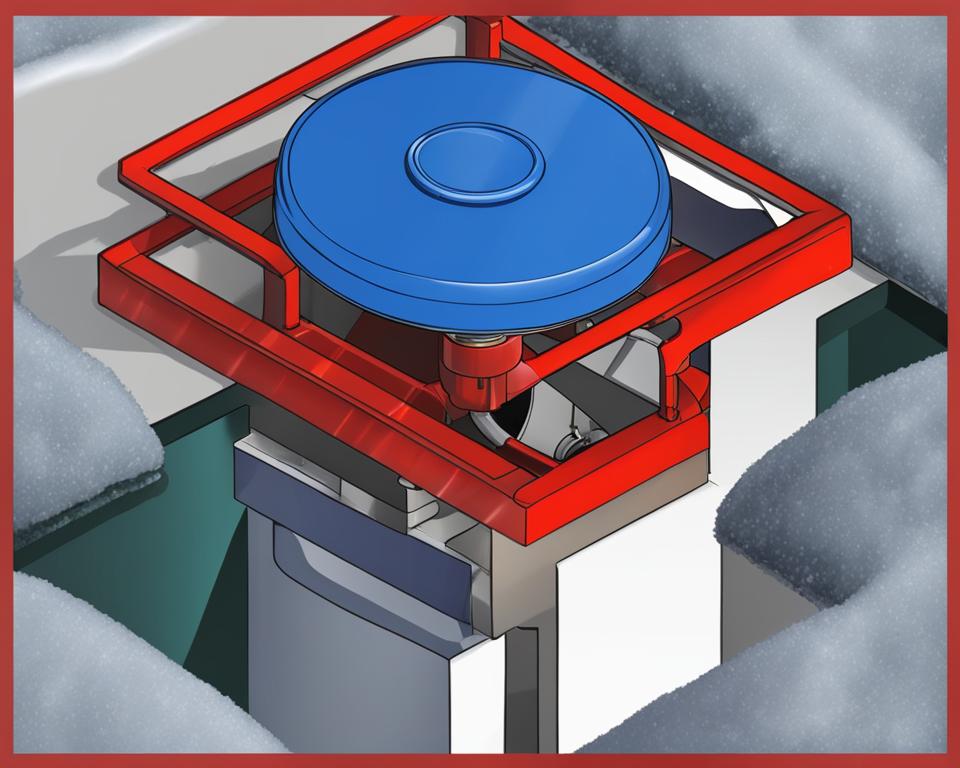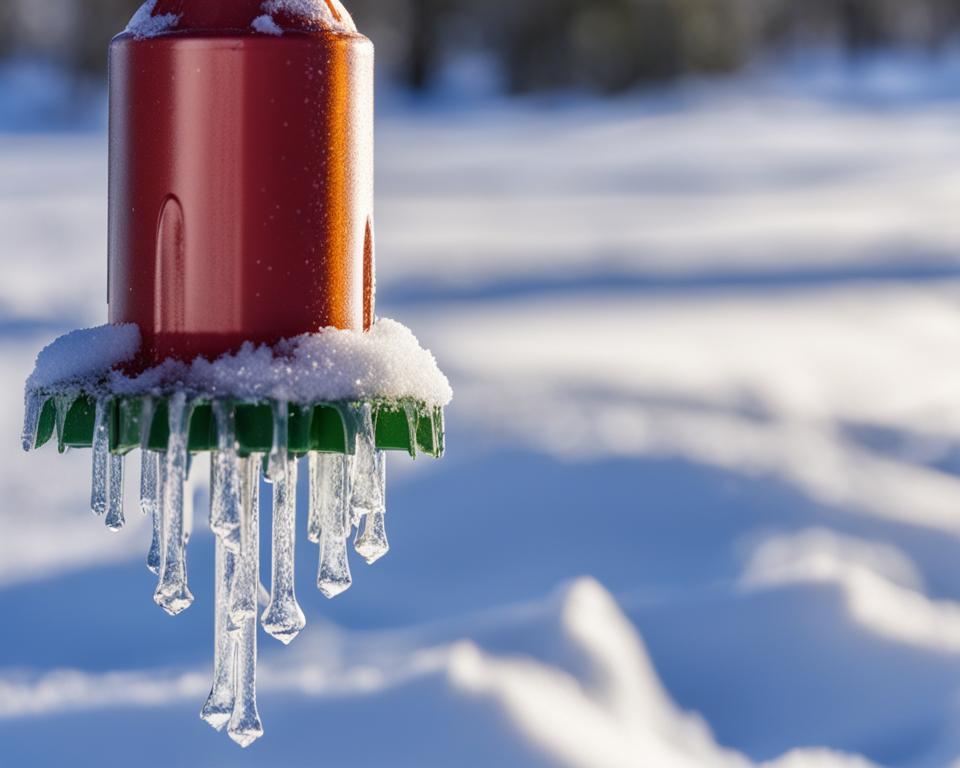As winter approaches, it’s important to take steps to protect your sprinkler system from freezing. Freezing temperatures can cause pipes to burst and damage your sprinkler system, resulting in costly repairs. By following a few simple steps, you can winterize your sprinklers and ensure they stay in good working condition.
Key Takeaways:
- Shut off the water supply and insulate the main shut off valve and above-ground piping to prevent freezing.
- Use the rain-mode or shut off the power to the controller to “shut down” the automatic system during winter.
- Drain the pipes and sprinklers to remove water that can freeze and cause them to burst.
- Insulate backflow preventers and valves located above ground with insulation tape for added protection.
- Seek professional assistance to properly winterize your sprinkler system and prevent freeze damage.
Insulating Your Sprinkler System Components
Winter maintenance for sprinkler systems is essential to avoid frozen sprinkler pipes and protect your outdoor sprinkler system. One important step in winterizing your system is insulating key components to prevent freeze damage.
Start by insulating the main shut off valve and above-ground piping with foam insulation or insulation tape. This provides an extra layer of protection against freezing temperatures. Additionally, you can use self-sticking foam-insulating tape or foam insulating tubes to insulate above-ground piping.
Don’t forget to insulate backflow preventers and valves located above ground as well. Use insulation tape to ensure proper airflow and drainage. By insulating these components, you can significantly reduce the risk of freeze damage to your sprinkler system.
In summary, insulating your sprinkler system components is a crucial step in winter maintenance. By wrapping the main shut off valve, above-ground piping, and insulating backflow preventers and valves, you can protect your outdoor sprinkler system from the harsh winter temperatures and avoid frozen pipes.
Shutting Down the Automatic System
Properly shutting down the automatic system of your sprinkler system during winter is essential to prevent freeze damage and ensure the longevity of your system. By taking a few simple steps, you can protect your sprinklers from frost and avoid costly repairs in the spring.
To begin, use the rain-mode feature on your system’s controller or shut off the power to the controller altogether. This will deactivate the automatic system and prevent it from accidentally turning on during freezing temperatures. If your controller activates a pump, make sure to disconnect the wires connected to the MV and common terminals to avoid any unintended activation.
Alternatively, you can shut off the power to the controller, but keep in mind that this will require reprogramming in the spring. Most system controllers have a rain-mode feature that halts signals to the valves while maintaining time and programming information. This is a convenient option that eliminates the need for reprogramming once winter is over.
By properly shutting down the automatic system of your sprinkler system, you can protect it from freeze damage and avoid the hassle of dealing with burst pipes or damaged components. Taking these precautions will ensure that your sprinklers are ready to go when spring arrives.
Table: Steps to Shut Down the Automatic System
| Steps | Explanation |
|---|---|
| Activate Rain Mode or Shut Off Power | Use the rain-mode feature on your system’s controller or shut off the power to prevent accidental activation during freezing temperatures. |
| Disconnect Wires | If your controller activates a pump, disconnect the wires connected to the MV and common terminals to prevent unintended activation. |
Draining the Pipes and Sprinklers
Properly draining your sprinkler system is an essential step in preventing freeze damage. When water freezes and expands within the pipes, it can cause them to burst, leading to costly repairs. By following the recommended steps for draining your pipes and sprinklers, you can avoid frozen sprinkler pipes and protect your system.
One method to drain the pipes is by using manual drain valves, which are typically located at the lowest points of the system. Opening these valves allows the water to flow out, ensuring there is no water left in the pipes that could freeze. Another option is using automatic drain valves that automatically release water when the system is turned off. These valves are designed to drain the water from the system, preventing freezing and potential damage. For a more thorough drain, you can also consider using compressed air blow-out techniques, which involve using compressed air to force the water out of the pipes. It is recommended to seek assistance from a local irrigation specialist for proper draining methods.
To summarize, draining the pipes and sprinklers is a crucial step in winterizing your sprinkler system. Whether you choose manual drain valves, automatic drain valves, or compressed air blow-out, ensuring that no water remains in the pipes will help prevent freeze damage and keep your system running smoothly.
Table: Methods for Draining Sprinkler Systems
| Method | Description |
|---|---|
| Manual Drain Valves | Open the manual drain valves located at the lowest points of the system to allow water to flow out. |
| Automatic Drain Valves | Automatically release water from the system when it is turned off to prevent freezing. |
| Compressed Air Blow-Out | Use compressed air to force the water out of the pipes for a thorough drain. |

| Benefits of Insulating Backflow Preventers and Valves |
|---|
| 1. Prevents freezing and cracking of the components |
| 2. Ensures proper airflow and drainage |
| 3. Reduces the risk of costly repairs |
| 4. Prolongs the lifespan of the irrigation system |
By taking the necessary steps to insulate your backflow preventers and valves, you can rest assured that your irrigation system will be protected from freeze damage. Don’t overlook this important aspect of winter maintenance for sprinkler systems. With proper insulation, you can enjoy a worry-free winter and a seamless transition into the spring season.
Conclusion
In conclusion, properly winterizing your sprinkler system is vital in protecting it from freeze damage. By following a few essential steps, you can ensure the longevity and functionality of your system during the winter months.
Firstly, insulating key components such as the main shut off valve, above-ground piping, backflow preventers, and valves is crucial. This can be done using foam insulation or insulation tape to safeguard them against freezing temperatures.
Secondly, shutting down the automatic system correctly is important. Utilize the rain-mode feature or shut off the power to the controller to prevent the system from operating during winter. Remember to remove any wires connected to the MV and common terminals to avoid accidental pump activation.
Lastly, draining the pipes and sprinklers is essential to remove any water that can freeze and cause them to burst. It’s recommended to seek professional assistance from a local irrigation specialist to ensure the pipes are thoroughly drained using methods such as manual drain valves, automatic drain valves, or compressed air blow-out.
By taking these necessary precautions and seeking professional help when needed, you can effectively winterize your sprinkler system and protect it from freezing. Don’t overlook the importance of proper maintenance during the winter months to avoid costly repair and ensure the longevity of your sprinkler system.
FAQ
How can I prevent my sprinklers from freezing during winter?
Shut off the water supply to the irrigation system, insulate the main shut off valve and above-ground piping, use the rain-mode or shut off the power to the controller, drain the pipes and sprinklers, and insulate backflow preventers and valves. Seek professional assistance if needed.
What should I do to insulate my sprinkler system components?
Insulate the main shut off valve and above-ground piping with foam insulation or insulation tape. Use self-sticking foam-insulating tape or foam insulating tubes to insulate above-ground piping. Insulate backflow preventers and valves located above ground with insulation tape, ensuring proper airflow and drainage.
How do I shut down the automatic system for winter?
Use the rain-mode or shut off the power to the controller. Remove wires connected to the MV and common terminals if the controller activates a pump. An alternative to using the rain mode is to shut off the power to the controller, but this requires reprogramming in the spring.
How do I drain the pipes and sprinklers to prevent freezing?
Contact a local irrigation specialist for assistance with draining the pipes using methods like manual drain valves, automatic drain valves, or compressed air blow-out. Removing water from the system is crucial in preventing freezing and expanding that can lead to burst pipes. Seek professional assistance to properly drain the pipes and sprinkler system.
How can I insulate backflow preventers and valves?
Insulate backflow preventers and valves located above ground with insulation tape, ensuring proper airflow and drainage. Proper insulation of these components helps protect them from freeze damage.
What is the importance of properly preparing and winterizing my sprinkler system?
Proper preparation and winterization of sprinkler systems are essential in preventing freeze damage and protecting the system from severe winter temperatures. Taking the recommended steps and getting professional assistance can help in this regard.


